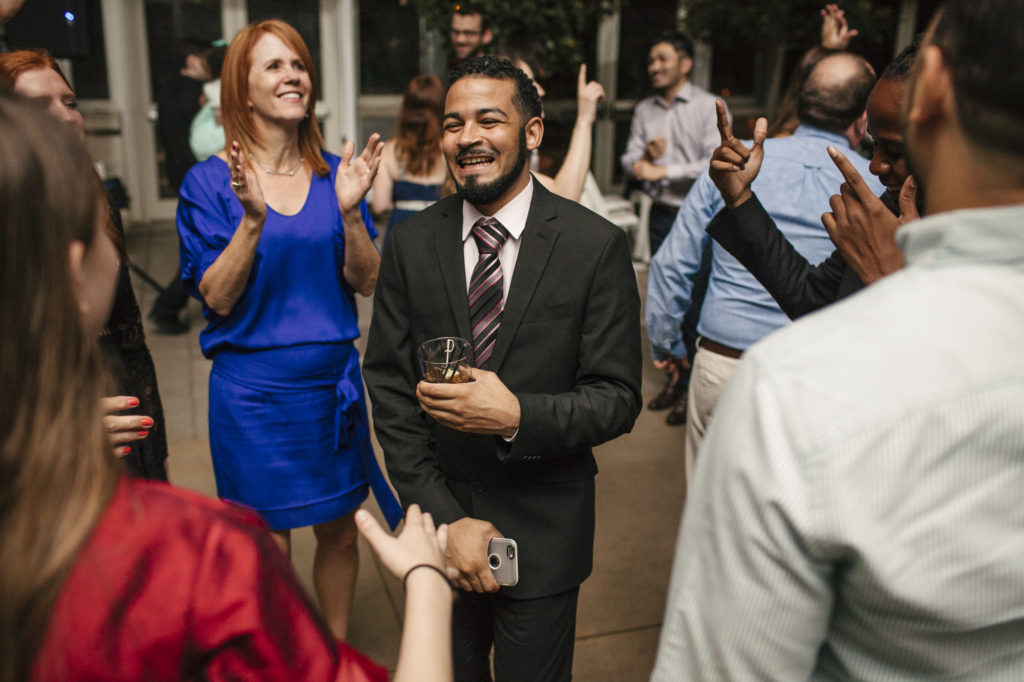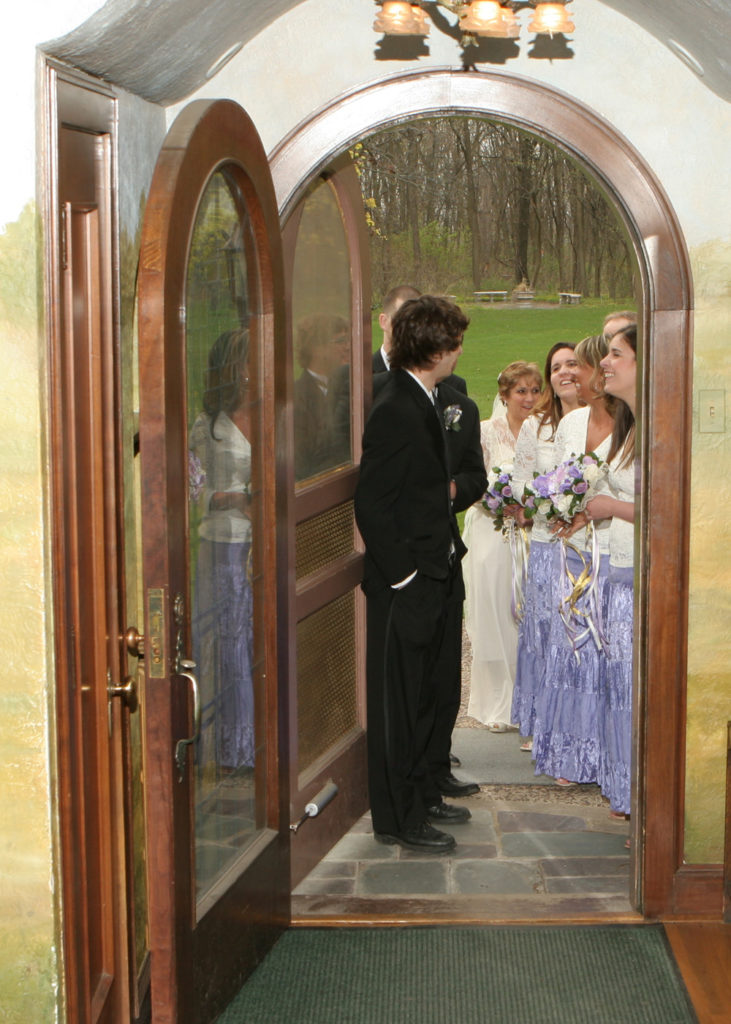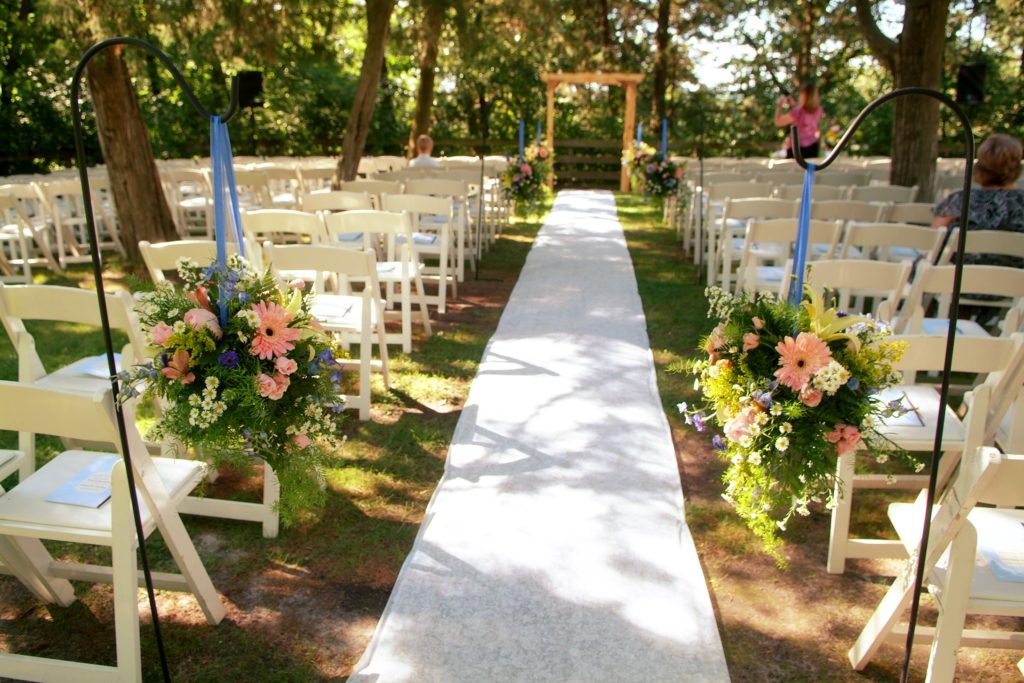Jan 7, 2019 | wedding planning

Having happy wedding guests starts with good communication. Photo by Becca Heuer Photography.
I always say that the things a planner can do for you are not limited to the ones you think of readily. Yes, sure, I can recommend excellent caterers and steer you clear of all sorts of pitfalls. Yes, I can likely save you money and time. But it’s the unexpected things I can do that are (in my opinion) my real value (See this post and this one for some of my previous thoughts on this subject.)
And I would say that one of the most valuable things I bring to the table is my ability to improve communications. I’ll give you a few examples.
A couple I was working with were interested in seeing a particular venue. Since I was doing only partial planning for them, it was their responsibility to contact the venue to arrange for a tour. They emailed the venue but never heard back. I was able to reach my contact at the venue and make an introduction after it became clear that the original message had gotten lost in transit.
Another time, a photographer I had recommended missed a message that had come in on a busy weekend and didn’t know that a couple was interested in hiring him. After a quick message from me, he noticed the missing message and was able to get back to them.
And, of course, a lot of what I do is to facilitate communication among the various vendors on any project. Since we all have to work together–and our work is all dependent on one another–much of my planning time is spent making sure that the caterer, the DJ, and the photographer all agree on the timeline for the event. I also facilitate communication among the caterer, the bakery, and the beverage supplier. And between the venue and the florist–and so many other things.
In many ways, the job of the planner is all about communication. Everyone needs to know what is going on, and someone has to make sure that they do. This isn’t something you’ll ever see, but it is one of the most important parts of planning any event. And it’s something a good planner can make sure always happens so that your wedding or other event goes off as planned.
Dec 12, 2018 | wedding planning

A good wedding venue is hard to find. Photo by MWD Photography.
Probably the first thing you are going to do if you are planning a wedding is look for a place to hold your wedding. This is somehow always a challenging process, so let me drop a few hints to help you on your way. How do you find the right venue?
Obviously, the first few things you need to know are a) where it is; b) how many people it can hold for the style of party you want; c) is it available on any dates you are considering, and d) how much does it cost? (About that “b),” keep in mind that you can fit more people into a room if they are standing up for a cocktail party than if they are all sitting down at large tables. And the fire marshal has the last word on how many people are permitted in a room.)
Once you have found out which places fit the bill on those four counts, it’s time to start visiting venues. As much information as you can get from a venue’s website, Instagram, and reviews, you really have to go there to see it for yourself. Every wedding is different, and not every location will be suitable for what you have in mind.
Here are some questions to ask yourself when you visit: Is the layout useful for the party you want? Does it have the right ambience or feel? Does it make you happy? It also goes without saying that you should ask practical questions, as well: What caterers are permitted on site? Are the restrooms adequate? What time is the venue available on the wedding day? Will it be accessible to guests who have mobility limitations? Is the owner or manager responsive to your needs?
One thing I have seen happen quite often is that the visit to the first venue changes your mind about what you want and how to accomplish it. Actually being in the place where the dream meets reality can be very formative in your ideas of how your wedding should be. And that’s actually a good thing. Don’t feel compelled to stick to your original vision if you find that it doesn’t stand up to reality. You should not be afraid to change direction at this point. It’s much better to change your mind now, rather than after you have committed large sums of money.
Another thing I’ve noticed is that, as a planner, I get faster and more thorough responses from venues than my clients do. When I do full planning, obviously I’m the point of contact. When I do partial planning, sometimes I give suggestions but my clients are the ones who get in touch with the venue. So, I get to see the difference in response time. I’d always rather make the first contact with a venue, because I know my clients will have a better experience if the venue knows there is a planner involved.
If you’re venue shopping, keep these things in mind as you go along. I think that finding a venue is one of the most difficult parts of wedding planning for most people. I hope you find it a little bit easier now!
Oct 31, 2018 | wedding planning

Here’s one location where an aisle runner might actually perform its intended function. Photo by Magical Moments Photography.
There’s one bit of wedding tradition that I usually recommend against, and that is the use of aisle runners. They are, fortunately, not as popular now as they were a few years ago, and I’m glad to see them go.
And what is so bad about them, you might ask? I find them to be terribly wasteful. The inexpensive ones that a florist typically supplies or that can be bought online are made from a non-woven synthetic fabric, such as polyester or polypropylene (both petroleum products). Needless to say, these runners anything but biodegradable. And they are a one-use item. After the wedding ceremony, the aisle runner will be thrown out. (I’ve personally thrown out more than one in my career.)
According to my colleague Lynn Fosbender of Pollen Floral Design, an aisle runner used to be a necessary item at a wedding before paved roads were found everywhere. The runner would be drawn down the aisle after the guests were seated to cover all the road dust so it wouldn’t soil the bride’s white gown. With that in mind, the only time a runner might still be useful would be at an outdoor wedding in a location where the aisle was bare dirt or rock.
If you find that a runner is necessary, or highly desirable, there are a few options for eco-friendly aisle runners. One possibility is to purchase a runner made from biodegradable materials, such as burlap, cotton canvas, or cotton duck. These tend to be more expensive than the disposable runners. Another option might be to find someone to make one for you out of a heavy, biodegradable material. This would definitely be more expensive!
Even if you can find (and afford) an aisle runner made from natural materials, the next question is what will become of it after the wedding ceremony. If you can re-sell it to someone who can use it, that would be one eco-friendly choice. Another possibility would be to re-purpose the fabric, if it is clean enough to use. (You could make a lot of throw pillows out of 75 feet of cotton duck!)
But it seems to me that there are very limited options in this realm of wedding paraphernalia. It isn’t easy to find an eco-friendly runner in the first place, and there are few things to do with it afterwards. All that is why I say, “Skip the aisle runner.” It’s a choice that is easy on your budget–and no one will miss it.
Sep 24, 2018 | wedding planning

Here is a bride who had exactly the wedding she wanted. Photo by Ryan Timm Photography.
A funny thing about being a wedding planner is that people I meet for the first time, when they find out what my job is, often ask me whether I have to deal with a lot of bridezillas. And they are always surprised when I inform them that pretty much all of the couples I work with are pleasant, easy to work with, and quite reasonable. Because I have to field this question so often, I have put some thought into why it is that my clients are not, on the whole, anywhere on the bridezilla scale. I’m still not sure I understand it completely, but I have some thoughts.
For one thing, I am the non-traditional wedding planner. It’s not that I don’t believe in traditions. I think traditions are lovely. But I also encourage my clients to break tradition when it suits their purposes. What does this have to do with being easy or difficult to be around? It means that my clients are likely not comparing their wedding plans to some unreasonable standard created by the wedding marketing machine. I think that that standard of perfection puts a lot of pressure on people planning weddings, which sometimes results in bad behavior–especially when there is any chance of something being less than “perfect.” When you create your own standard for how you want your wedding to be, it takes a lot of external pressure off the planning and a lot of pressure off of you.
There is another sort of thing that goes on that also creates bridezillas. This one is a little more complicated. Many people raised female have been told (implicitly and explicitly) their whole lives that what they want doesn’t count, that other people’s opinions and wants are far more important than their own. And so they often don’t learn (or don’t learn by the time they are planning their weddings) to say no to other people or to say yes to themselves.
I think what happens when someone planning a wedding can’t say no to other people is that they end up with a wedding that secretly they hate. It might be “perfect” according to whatever standard they are using, but it isn’t what they wanted because they didn’t start out by saying yes to themselves. And they never learned to say no to whatever other people are pushing. They never learned to do what I always encourage my clients to do: Have the wedding you want, even if it breaks all the rules.
Unfortunately, I’m afraid that what happens under these circumstances is you end up with a woman (it’s almost always a woman) who is miserably unhappy about the perfect wedding she is planning, and she takes out her misery on anyone in the vicinity. And that is one thing we would call bridezilla behavior.
So, here is my advice to you if you are planning your wedding (no matter your gender): Before you sign a single contract, sit down with your partner in life and talk over what kind of wedding you want to have. Bring a planner into the discussion if you think that will help to clarify your thinking. Throw out all the “shoulds” and “have tos” and “everyone does this-es.” Decide how much influence you want your families to have over the planning. And then start to make decisions about the details of your wedding. If you are happy with your wedding, chances are you will make everyone around you happy about it, too.
Jul 23, 2018 | wedding planning
This is part three of this series on budget party planning. Here’s an in-depth look at budgeting for the food at your event:

Photo courtesy of Artisan Events, Inc.
One very important thing you can do to control your catering costs is to have a fairly firm budget number in mind before you talk to a caterer. Every client I have ever told this to says, “But I don’t know what it costs.” That’s the secret: You tell the caterer how much you want to spend and it is up to them to come up with a menu within your budget. Don’t expect caviar on a frugal budget, of course, and do discuss your target budget number with any potential caterer. A good one will be able to tell you if what you are asking for is even reasonable. If you don’t go in with a budget number, they will start at the high end. You can make adjustments as you go along, of course, but it is easiest to start with your budget amount.
One way to think about your catering budget is to break it down into two (or three parts). First, consider how much per person you want to spend on food alone. Compare your per person price to what you might pay in a restaurant. At a highest-end restaurant, you could easily spend $100 per person for dinner, or more. But at a high quality neighborhood restaurant, you can get away with $40 per person. Of course, the prices at a restaurant also include a different kind of overhead from the caterer, but this gives you a way to start thinking about the costs. Float a per-person number with any caterer you talk to and see if they think they can come up with a menu in that price range. If three or four caterers find your numbers too low, you may have to increase them. But you should be able to find someone to work within any reasonable budget.
The second part of your catering budget is service–what you are paying for the chef, servers, and other kitchen workers. Most caterers charge service per worker per hour, and they will break this number down on your estimate. A less scrupulous practice is to charge service at a flat cost per guest. This method does not reflect the caterer’s actual expenses and may end up costing you more. A third method is to charge service as a percentage of food costs. If a caterer insists on charging a flat rate per guest and won’t give you actual service costs, consider looking elsewhere, unless you find that they actually have the best price.
If you want to cut down on service costs, you might consider buffet service, which requires fewer people to give smooth service. On the other hand, caterers generally must provide more food for a buffet than for plated service, which might offset the savings provided by fewer servers. Ask your caterer if buffet is an option for you and see if a buffet will offer you savings. It depends on a lot of factors: price of labor, price of food, number of guests, etc. A conscientious caterer can give you a comparison of the prices.
Depending on your venue and your caterer, the third part of any estimate you receive may be rental equipment charges. These charges should show up separately from food and service on your catering estimate. Some caterers will break out the rental list with prices for each item so you can see what they expect you to pay. Most caterers will not do this, however, and if you want to compare the details, you may need either a rental catalogue and an Excel spreadsheet or the help of a planner. I have actually broken down rental costs for a client and compared them to the prices I would expect to pay to help her to see the true costs of the proposal. Rentals can add up to a substantial sum of money, so don’t overlook the necessity if you are at a venue that doesn’t supply everything you need. There are ways to control cost here, too, although not as many. You can rent flat linens, instead of glossy, and you can rent the least expensive china, silverware, and glassware. You can also shop around among rental houses for good prices. Be aware, however, that there are rental companies that offer good prices but substandard service. Get recommendations or references for rentals so you are not stuck with poor service or dingy equipment.
Always start with your food budget number before you begin your shopping. You may have to revise this number as you get a feel for realistic costs, but don’t believe anyone who tells you that you can’t feed a crowd for less than $100 per person in food costs. If you are creative and are working with a flexible caterer, you can have a celebration to remember without breaking the bank.
Jul 2, 2018 | wedding planning

Non-traditional venues definitely come with some additional planning needs. (Photo by Allison Williams Photography.)
As you’re planning your wedding (or any celebration), do you ever have that nagging feeling that you are forgetting something? You may be–and the things you aren’t thinking of are all completely glamor-less. Here are a few things you might want to add to your to-do list:
- Garbage. Your party is probably going to generate some garbage. You can reduce the amount by focusing on recycling and composting, but there is going to be some. If you’ve hired a full-service caterer, you probably don’t have to give it any more thought. If you are having a party at home, in a non-traditional venue, and/or without a full-service caterer, it is always going to be a consideration. Do you have enough garbage/recycling receptacles? Do you have enough garbage bags? Where does the trash go after the party? Is it going to cost anything to dispose of it?
- Bathrooms. Again, if you’re in one of the many usual places for weddings and parties, this is probably not something you need to think about. But for large parties at home or somewhere unusual (forest preserve??), it deserves some thought. What kinds of facilities are available? Are they well kept? Are there enough of them? Do you need to rent portable restrooms? What are the rules about that? Do you want to spend the extra money to get the really nice ones?
- Clean-up. No matter where your party is (except, maybe, at home), there will be stuff that needs to be removed after the fun is over. This is generally the last thing people think of, but you can get a jump on it now. Who will take the decor, the gifts, the leftovers? How will they be transported? And what happens to them afterwards? Do you want your guests to take home anything? As I said, it’s not glamorous, but it’s important.
As you’re doing your planning, keep all these things in mind so you don’t have any unpleasant surprises. After all that, is what good planning is all about!







Recent Comments